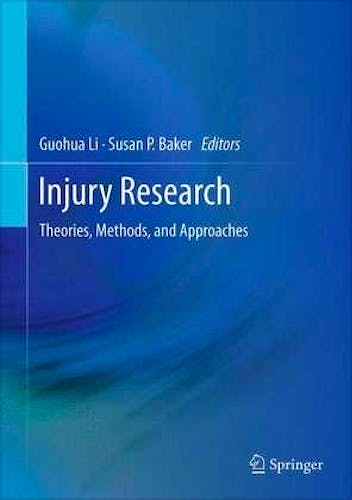

No hay productos en el carrito



Injury Research. Theories, Methods, and Approaches
Li, — Baker, S.
1ª Edición Febrero 2012
Inglés
Tapa dura
676 pags
1441 gr
18 x 26 x 4 cm
ISBN 9781461415985
Editorial SPRINGER
LIBRO IMPRESO
-73%
259,99 €69,00 €IVA incluido
249,99 €66,35 €IVA no incluido
Producto en Liquidación
ABOUT THIS BOOK
- First text focusing on contemporary injury research methods, illustrated by real examples
- Covers recent developments in theories, methods, concepts, and techniques in injury research
- Includes quantitative, qualitative, experimental, and observational methods from multiple disciplines
From the long-held popular belief, “accidents will happen,” it is now recognized that this needn’t be the case. More and more, injury is being seen as no accident, not only predictable, but preventable—and an important public health issue requiring rigorous study and multiple levels of intervention.
To this end, Injury Research: Theories, Methods, and Approaches assembles a team of multidisciplinary experts from around the globe. Early chapters provide a solid foundation for gathering injury data and monitoring trends. Research methods and injury-reduction approaches gleaned from public health, medicine, engineering, behavioral science, and other areas demonstrate both the intricacies of causation and the potential for intervention. The result is an authoritative and comprehensive reference relevant across professional fields, geared toward fruitful collaborations
Injury Research is a bedrock text for graduate students and researchers in public health, medicine, biomechanical engineering, safety engineering, and behavioral science working in injury control, violence prevention, emergency medical services, trauma care, risk assessment, accident investigation and litigation, traffic safety, home safety, vehicle and product design, patient safety, health promotion, and public policy. Professionals working in health departments, the insurance sector, health economics, environmental engineering, civil engineering, urban planning, law enforcement, and criminal justice should find it important reading as well.
Content Level » Research
Related subjects » Medicine - Public Health
TABLE OF CONTENTS
- Part I. Injury Surveillance.
- Chapter 1. Surveillance of Injury Mortality.
- Chapter 2. Surveillance of Injury Morbidity.
- Chapter 3. Injury Surveillance in Special Populations.
- Chapter 4. Surveillance of Traumatic Brain Injury.
- Part II. Injury Causation.
- Chapter 5. Forensic Patholoy.
- Chapter 6. Determination of Injury Mechanisms.
- Chapter 7. Ergonomics.
- Chapter 8. Experimental Methods.
- Chapter 9. Epidemiologic Methods.
- Chapter 10. Qualitative Methods.
- Chapter 11. Environmental Determinants.
- Chapter 12. Behavioral Determinants.
- Part III. Injury Outcome.
- Chapter 13. Injury Profiling.
- Chapter 14. Injury Severity Scaling.
- Chapter 15. Triage.
- Chapter 16. Prediction Rules.
- Chapter 17. Biomarkers of Traumatic Injuries.
- Chapter 18. Functional Outcomes.
- Chapter 19. Injury Costing Frameworks.
- Part IV. Analytical Approaches.
- Chapter 20. Statistical Considerations.
- Chapter 21. Video Data Analysis.
- Chapter 22. Age-Period-Cohort Modeling.
- Chapter 23. Multilevel Modeling.
- Chapter 24. Geographic Information Systems.
- Chapter 25. Spatial Regression.
- Chapter 26. Social Network Analysis.
- Part V. Approaches to Injury Reduction.
- Chapter 27. Legal Approach.
- Chapter 28. Public Policy.
- Chapter 29. Environmental Approach.
- Chapter 30. Technological Approach.
- Chapter 31. Behavioral Approach.
- Chapter 32. EMS and Trauma Systems.
- Chapter 33. Systems Approach to Patient Safety.
- Chapter 34. Intervention in Low-Income Countries.
- Chapter 35. Implementing and Evaluating Interventions.
- Chapter 36. Economic Evaluation of Interventions.
AUTHORS & EDITORS
Dr. Guohua Li is the Finster Professor of Epidemiology at the Columbia University Mailman School of Public Health and College of Physicians & Surgeons. A medical epidemiologist, Dr. Li is interested in research methodology and injury-related, population-based and policy-oriented studies that encompass innovative epidemiologic designs, novel biostatistical techniques, and complex data systems. Dr. Li has published over 130 manuscripts in peer-reviewed journals and is well known for his studies of aviation crashes and the role of alcohol in injury causation and trauma outcomes. A Guggenheim Fellow and a Fellow of the American College of Epidemiology, Dr. Li is the recipient of the Kenneth Rothman Epidemiology Prize (1999) and the John Paul Stapp Award (2009).
Dr. Susan P. Baker is the Professor of Health Policy and Management and the founding director of the Center for Injury Research and Policy at the Johns Hopkins Bloomberg School of Public Health. She is widely recognized as one of the founders of the scientific discipline of injury epidemiology and prevention and is credited for developing the Injury Severity Score, a simple and effective tool for measuring the severity of multiple trauma that has been used worldwide by clinicians and researchers. She has authored over 300 publications, including the influential text Injury Fact Book, 1st and 2nd editions. Prof. Baker has received numerous awards, including the Charles A. Dana Award for Pioneering Achievements in Health and Higher Education and the Excellence in Research Award of the American Public Health Association.
© 2025 Axón Librería S.L.
2.149.0